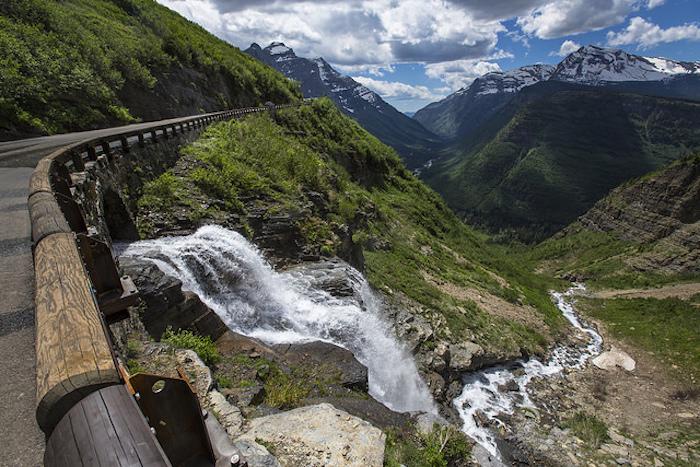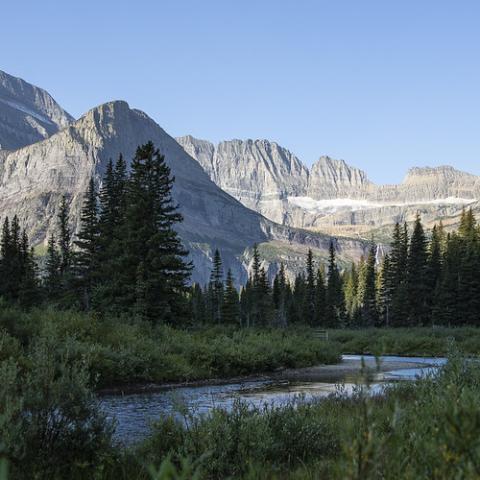
An Idaho teen was swept to his death by Haystack Creek as it passed beneath the Going-to-the-Sun Road/NPS file, Jacob W. Frank
A 15-year-old Idaho boy was swept to his death in a fall of about 100 feet after he slipped into Haystack Creek as it flowed beneath Going-to-the-Sun Road in Glacier National Park in Montana.
Park staff said Spencer Flerchinger, of Kamiah, Idaho, was in the culvert that carried the creek beneath the road Tuesday evening, slipped into the creek, and "was carried through, falling approximately 100 feet below the roadway." He was visiting the park with his parents.
The Going-to-the-Sun Road was restricted to one lane for about three hours Tuesday evening near the incident, and temporarily closed for approximately 10 minutes to traffic in both directions while rangers secured the scene of the accident and recovered the boy's body from a ledge below the road via litter carryout.
A similar fatality occurred at that spot in July 2017 when a person fell into the creek above the culvert while taking a photograph, park staff recalled. While falls into water features are a common cause of injury and death, the recent occurrence of another fatality at the same location is not commonplace.
“It’s often the case that people hear about a tragic incident like this and think that it couldn’t happen to them,” said Glacier Chief Ranger Paul Austin. “The facts are that many people explore the park each day in ways that could result in a serious accident. Take a few minutes before your trip to public lands to identify significant hazards. Prepare for the possibility of getting lost on a trail or an unexpected animal encounter. Stay away from rushing creeks and sheer drops.”
Visitors are urged to use extreme caution while recreating in the park. Unpredictable wildlife, extreme natural features, and other hazards exist in nearly all locations, including areas that may seem relatively safe. Glacier has 42 named waterfalls in addition to unnamed creeks and falls, and tens of miles of roadway that border steep cliffs. Falls in and near water features are a leading cause of death and visitors should avoid areas with slippery rocks that might result in a significant fall.

Haystack Creek above Going-to-the-Sun Road, Glacier National Park/NPS, Jacob W. Frank




 Support Essential Coverage of Essential Places
Support Essential Coverage of Essential Places







Comments
i miss my friend...
I was visiting the park at the time this happened and drove by as the rangers were down the cliff recovering the body. Obviously I was completely horrified because I am terrified of hights and Going-To-The-Sun Road is literally all cliff. Everyone in my car went silent as we passed who I assume was the father. His head was burried into his arms as he was leaning on a car. Such a horrible accident. I like to think that this precious child ended his life in such a gorgeous place.
I do not think it is at all disrespectful of this grevious happening to discuss what might be/could be/should be done to decrease chances of it happening again. Notice I said "decrease" chances, because nothing could possibly eliminate all possible mishaps in the great outdoors. Or in your own living room as far as that goes! Perhaps the culvert should have had a grate (though if the grate openings were big enough to allow storm debris to flow through, then how difficult would it be for a healthy person to squeeze past?) Perhaps an adult more cognizant of the dangers should have been keeping an eye on adventurous teens -- at that age, we all think we'll live forever. But when we venture into the areas where we haven't yet padded all the corners, put up fences and walls on every slope more than 10' high and corraled all threatening wildlife into cages, we have to accept that bad stuff happens. That makes it no less tragic, nor should we rush to judgement, find someone handy to blame. But if we did everything humanly possible to eliminate the dangers, we would not have any wildnerness left
youre upset because he basically spoke the truth. You can't save people from themselves and sympathy for those that take risk without any consideration to safety are a breed of people that are out there. Those that put their lives in danger for heroic acts have a purpose and a meaning to do so. Those that put their lives in danger for lack of common sense or complacency are entirely different. if you can't handle the truth nor another's opinion, then perhaps comments are not your thing.
One can draw a truthful distiction between reckless conduct of an adult and the behavior and risk assessment skills of a 15 year old.
Some people just have to condemn to make themselves feel safer and better than others. It's a societal disease.
my 14 year old son was in a different less dangerous culvert in glacier last week bc of the acoustics - they are exploring you are right - this is so tragic I can't bear it
I was the shuttle bus driver that saw the person in 2017 fall to his death and i called it in to the park rangers. I still kept driving the bus which I felt so bad when I drove the white buses past haystack it took time. But I felt I had to do something so I stopped at the ranger station and mentioned that they should put some rebar so if somebody started to go threw they could grab the rebar and save there life. it would be nothing major to do and very little expense. I feel I did my part then 2 years latter it happens again. I feel good I said something to maybe prevent another death but nothing got done and iam sad for the 15 year old and for the person and his family from corvolis mont. It still bothers me inside.
It seems like a chain-link or rebar screen on the upstream side of this bridge might help prevent future accidents. It could be built cheaply in-house and sections hung from the bridge railing or on rock bolts each summer by the road crew as they plow the road, then removed each Fall.